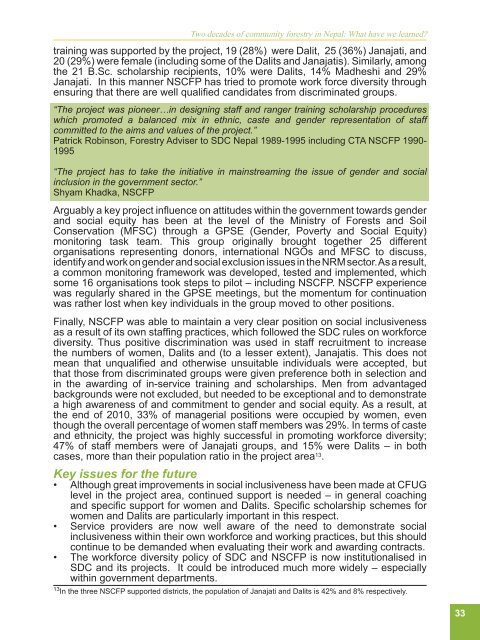Two decades of community forestry in Nepal: What have we learned?
Two decades of community forestry in Nepal: What have we learned?
Two decades of community forestry in Nepal: What have we learned?
Create successful ePaper yourself
Turn your PDF publications into a flip-book with our unique Google optimized e-Paper software.
<strong>Two</strong> <strong>decades</strong> <strong>of</strong> <strong>community</strong> <strong>forestry</strong> <strong>in</strong> <strong>Nepal</strong>: <strong>What</strong> <strong>have</strong> <strong>we</strong> <strong>learned</strong>?<br />
tra<strong>in</strong><strong>in</strong>g was supported by the project, 19 (28%) <strong>we</strong>re Dalit, 25 (36%) Janajati, and<br />
20 (29%) <strong>we</strong>re female (<strong>in</strong>clud<strong>in</strong>g some <strong>of</strong> the Dalits and Janajatis). Similarly, among<br />
the 21 B.Sc. scholarship recipients, 10% <strong>we</strong>re Dalits, 14% Madheshi and 29%<br />
Janajati. In this manner NSCFP has tried to promote work force diversity through<br />
ensur<strong>in</strong>g that there are <strong>we</strong>ll qualifi ed candidates from discrim<strong>in</strong>ated groups.<br />
“The project was pioneer…<strong>in</strong> design<strong>in</strong>g staff and ranger tra<strong>in</strong><strong>in</strong>g scholarship procedures<br />
which promoted a balanced mix <strong>in</strong> ethnic, caste and gender representation <strong>of</strong> staff<br />
committed to the aims and values <strong>of</strong> the project.”<br />
Patrick Rob<strong>in</strong>son, Forestry Adviser to SDC <strong>Nepal</strong> 1989-1995 <strong>in</strong>clud<strong>in</strong>g CTA NSCFP 1990-<br />
1995<br />
“The project has to take the <strong>in</strong>itiative <strong>in</strong> ma<strong>in</strong>stream<strong>in</strong>g the issue <strong>of</strong> gender and social<br />
<strong>in</strong>clusion <strong>in</strong> the government sector.”<br />
Shyam Khadka, NSCFP<br />
Arguably a key project <strong>in</strong>fl uence on attitudes with<strong>in</strong> the government towards gender<br />
and social equity has been at the level <strong>of</strong> the M<strong>in</strong>istry <strong>of</strong> Forests and Soil<br />
Conservation (MFSC) through a GPSE (Gender, Poverty and Social Equity)<br />
monitor<strong>in</strong>g task team. This group orig<strong>in</strong>ally brought together 25 different<br />
organisations represent<strong>in</strong>g donors, <strong>in</strong>ternational NGOs and MFSC to discuss,<br />
identify and work on gender and social exclusion issues <strong>in</strong> the NRM sector. As a result,<br />
a common monitor<strong>in</strong>g framework was developed, tested and implemented, which<br />
some 16 organisations took steps to pilot – <strong>in</strong>clud<strong>in</strong>g NSCFP. NSCFP experience<br />
was regularly shared <strong>in</strong> the GPSE meet<strong>in</strong>gs, but the momentum for cont<strong>in</strong>uation<br />
was rather lost when key <strong>in</strong>dividuals <strong>in</strong> the group moved to other positions.<br />
F<strong>in</strong>ally, NSCFP was able to ma<strong>in</strong>ta<strong>in</strong> a very clear position on social <strong>in</strong>clusiveness<br />
as a result <strong>of</strong> its own staffi ng practices, which follo<strong>we</strong>d the SDC rules on workforce<br />
diversity. Thus positive discrim<strong>in</strong>ation was used <strong>in</strong> staff recruitment to <strong>in</strong>crease<br />
the numbers <strong>of</strong> women, Dalits and (to a lesser extent), Janajatis. This does not<br />
mean that unqualifi ed and otherwise unsuitable <strong>in</strong>dividuals <strong>we</strong>re accepted, but<br />
that those from discrim<strong>in</strong>ated groups <strong>we</strong>re given preference both <strong>in</strong> selection and<br />
<strong>in</strong> the award<strong>in</strong>g <strong>of</strong> <strong>in</strong>-service tra<strong>in</strong><strong>in</strong>g and scholarships. Men from advantaged<br />
backgrounds <strong>we</strong>re not excluded, but needed to be exceptional and to demonstrate<br />
a high awareness <strong>of</strong> and commitment to gender and social equity. As a result, at<br />
the end <strong>of</strong> 2010, 33% <strong>of</strong> managerial positions <strong>we</strong>re occupied by women, even<br />
though the overall percentage <strong>of</strong> women staff members was 29%. In terms <strong>of</strong> caste<br />
and ethnicity, the project was highly successful <strong>in</strong> promot<strong>in</strong>g workforce diversity;<br />
47% <strong>of</strong> staff members <strong>we</strong>re <strong>of</strong> Janajati groups, and 15% <strong>we</strong>re Dalits – <strong>in</strong> both<br />
cases, more than their population ratio <strong>in</strong> the project area 13 .<br />
Key issues for the future<br />
• Although great improvements <strong>in</strong> social <strong>in</strong>clusiveness <strong>have</strong> been made at CFUG<br />
level <strong>in</strong> the project area, cont<strong>in</strong>ued support is needed – <strong>in</strong> general coach<strong>in</strong>g<br />
and specifi c support for women and Dalits. Specifi c scholarship schemes for<br />
women and Dalits are particularly important <strong>in</strong> this respect.<br />
• Service providers are now <strong>we</strong>ll aware <strong>of</strong> the need to demonstrate social<br />
<strong>in</strong>clusiveness with<strong>in</strong> their own workforce and work<strong>in</strong>g practices, but this should<br />
cont<strong>in</strong>ue to be demanded when evaluat<strong>in</strong>g their work and award<strong>in</strong>g contracts.<br />
• The workforce diversity policy <strong>of</strong> SDC and NSCFP is now <strong>in</strong>stitutionalised <strong>in</strong><br />
SDC and its projects. It could be <strong>in</strong>troduced much more widely – especially<br />
with<strong>in</strong> government departments.<br />
13 In the three NSCFP supported districts, the population <strong>of</strong> Janajati and Dalits is 42% and 8% respectively.<br />
33

















